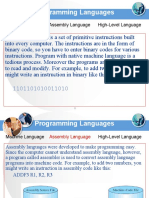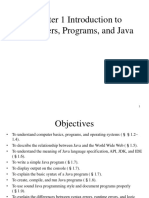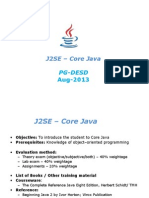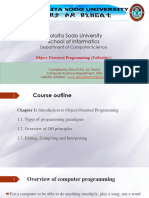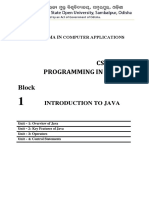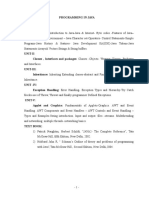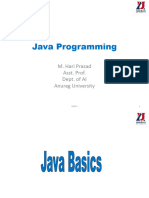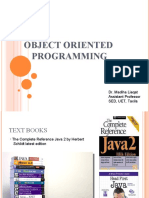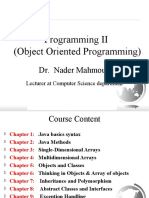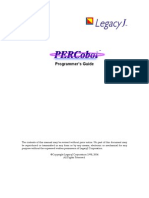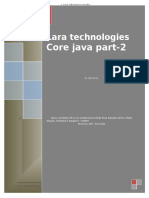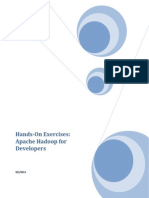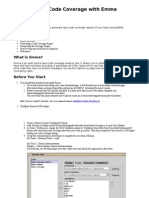Introduction to Object Oriented Programming
Course Name: Object Oriented Programming using Java Faculty: Mukhtaj Khan and Ms Sidra Credit Hours: (3+1) 4 Teaching Methodology: (1). 3 hrs Lecturers (2). 3 hrs Labs Lecturers: (i). 2 hrs and (ii) 1 hrs
�Cont
Marks Distribution: (i). Mid Term: 25% (ii). Labs / Assignments : 10% (iii). Quizzes : 10% (vi). Project : 15% (v). Final Exam: 40%
�Course Contents
Chapter 1 : Introduction to Java Programming Chapter 2: Elementary Programming Chapter 3: Selections Statement Chapter 4: Loops Chapter 5: Methods Chapter 6: Arrays Chapter 7: Object and Classes Chapter 8: Strings and Text I/O Chapter 9: Thinking in Objects Chapter 10: Inheritance and Polymorphism
�Text and Reference Books
Text Book: Introduction to Java Programming 6th Edition, by Y. Daniel Liang (Soft Copy Available for Students) Reference Books: (i) Java How to Program 6th Edition, H.M. Deitel and P.J. Deitel (ii). Java Programming Complete Reference (iii). Java programming language handbook 1 & 2, by David H Friedel Group: http://groups.google.com/group/ee112_oop
�Introduction to Computer Programming languages. To understand the relationship between Java and the World Wide Web (1.6). To know Javas advantages (1.7). To distinguish the terms API, IDE, and JDK (1.8). To write a simple Java program (1.9). To create, compile, and run Java programs (1.10). To understand the Java runtime environment (1.10). To know the basic syntax of a Java program (1.11). To display output on the console and on the dialog box (1.12).
Chapter I: Introduction to Java Prog. Objectives
�Programs
Computer programs, known as software, are instructions to the computer. Without programs, a computer is an empty machine. Computers do not understand human languages, so you need to use computer languages to communicate with them.
Programs are written using programming languages.
�Programming Languages
Machine Language Assembly Language High-Level Language
Machine language is a set of primitive instructions built into every computer. The instructions are in the form of binary code, so you have to enter binary codes for various instructions. Program with native machine language is a tedious process. Moreover the programs are highly difficult to read and modify. For example, to add two numbers, you might write an instruction in binary like this:
1101101010011010
7
�Programming Languages
Machine Language Assembly Language High-Level Language
Assembly languages were developed to make programming easy. Since the computer cannot understand assembly language, however, a program called assembler is used to convert assembly language programs into machine code. For example, to add two numbers, you might write an instruction in assembly code like this: ADDF3 R1, R2, R3
Assembly Source File ADDF3 R1, R2, R3 Machine Code File
Assembler
1101101010011010
�Programming Languages
Machine Language Assembly Language High-Level Language
The high-level languages are English-like and easy to learn and program. For example, the following is a high-level language statement that computes the area of a circle with radius 5: area = 5 * 5 * 3.1415;
�Popular High-Level Languages
COBOL
(COmmon Business Oriented Language) FORTRAN (FORmula TRANslation) BASIC (Beginner All-purpose Symbolic Instructional Code) Pascal (named for Blaise Pascal) Ada (named for Ada Lovelace) C (whose developer designed B first) Visual Basic (Basic-like visual language developed by Microsoft) Delphi (Pascal-like visual language developed by Borland) C++ (an object-oriented language, based on C) Java (We use it in the book)
10
�Compiling Source Code
A program written in a high-level language is called a source program. Since a computer cannot understand a source program. Program called a compiler is used to translate the source program into a machine language program called an object program. The object program is often then linked with other supporting library code before the object can be executed on the machine.
Source File
Compiler
Object File
Linker
Excutable File
11
�Compiling Java Source Code
You can port a source program to any machine with appropriate compilers. The source program must be recompiled, however, because the object program can only run on a specific machine. Nowadays computers are networked to work together. Java was designed to run object programs on any platform. With Java, you write the program once, and compile the source program into a special type of object code, known as bytecode. The bytecode can then run on any computer with a Java Virtual Machine, as shown in Figure 1.5. Java Virtual Machine is a software that interprets Java bytecode.
Java Bytecode Java Virtual Machine Any Computer
12
�Object Oriented Programming (OOP)
OOP is a programming language model organized around : Object (State & behavior) Class (blueprint or prototype) Inheritance (inherit state and behavior) Method (an action) data hiding ( pubic, private, protect) interface ( communication Java API) Package ( a namespaces for org classes)
�Java
Java
Originally for intelligent consumer-electronic devices Then used for creating Web pages with dynamic content Now also used to: Develop large-scale enterprise applications Enhance WWW server functionality Provide applications for consumer devices (cell phones, etc.)
�Javas History
James Oak Java,
Gosling and Sun Microsystems
May 20, 1995, Sun World
HotJava
The first Java-enabled Web browser
Early
History Website:
http://java.sun.com/features/1998/05/birthday.html
15
�Why Java?
The answer is that Java enables users to develop and deploy applications on the Internet for servers, desktop computers, and small hand-held devices. The future of computing is being profoundly influenced by the Internet, and Java promises to remain a big part of that future.
Java
Java
is a general purpose programming language.
is the Internet programming language.
16
�Java, Web, and Beyond
Java
can be used to develop Web applications. Java Applets Java Servlets and Java Server Pages Java can also be used to develop applications for hand-held devices such as Palm and cell phones (J2ME)
17
�Examples of Javas Versatility
Standalone Application: TicTacToe Applet:
TicTacToe SelfTest Web site Computing: Cell phones
Servlets: Mobile
18
�TicTacToe Standalone
19
�TicTacToe Applet
20
�SelfTest Website (using Java Servlets)
21
�PDA and Cell Phone
22
�Optional
Characteristics of Java
Java Is Simple Java Is Object-Oriented Java Is Distributed Java Is Interpreted Java Is Robust Java Is Secure Java Is Architecture-Neutral Java Is Portable Java's Performance Java Is Multithreaded Java Is Dynamic
www.cs.armstrong.edu/liang/intro6e/JavaCharacteristics.pdf
23
�Optional
Characteristics of Java
Java is partially modeled on C++, but greatly Java Is Simple simplified and improved. Some people refer to Java Is Object-Oriented Java as "C++--" because it is like C++ but with more functionality and fewer negative Java Is Distributed aspects. Java Is Interpreted Java Is Robust Java Is Secure Java Is Architecture-Neutral Java Is Portable Java's Performance Java Is Multithreaded Java Is Dynamic
24
�Optional
Characteristics of Java
Java is inherently object-oriented. Although many object-oriented languages began strictly as procedural languages, Java was designed from the start to be object-oriented. Object-oriented programming (OOP) is a popular programming approach that is replacing traditional procedural programming techniques. One of the central issues in software development is how to reuse code. Objectoriented programming provides great flexibility, modularity, clarity, and reusability through encapsulation, inheritance, and polymorphism.
Java Is Simple Java Is Object-Oriented Java Is Distributed Java Is Interpreted Java Is Robust Java Is Secure Java Is Architecture-Neutral Java Is Portable Java's Performance Java Is Multithreaded Java Is Dynamic
25
�Optional
Characteristics of Java
Distributed computing involves several computers working together on a network. Java is designed to make distributed computing easy. Since networking capability is inherently integrated into Java, writing network programs is like sending and receiving data to and from a file.
Java Is Simple Java Is Object-Oriented Java Is Distributed Java Is Interpreted Java Is Robust Java Is Secure Java Is Architecture-Neutral Java Is Portable Java's Performance Java Is Multithreaded Java Is Dynamic
26
�Optional
Characteristics of Java
You need an interpreter to run Java programs. The programs are compiled into the Java Virtual Machine code called bytecode. The bytecode is machineindependent and can run on any machine that has a Java interpreter, which is part of the Java Virtual Machine (JVM).
Java Is Simple Java Is Object-Oriented Java Is Distributed Java Is Interpreted Java Is Robust Java Is Secure Java Is Architecture-Neutral Java Is Portable Java's Performance Java Is Multithreaded Java Is Dynamic
27
�Optional
Characteristics of Java
Java compilers can detect many problems that would first show up at execution time in other languages. Java has eliminated certain types of errorprone programming constructs found in other languages.
Java Is Simple Java Is Object-Oriented Java Is Distributed Java Is Interpreted Java Is Robust Java Is Secure Java Is Architecture-Neutral Java Is Portable Java's Performance Java Is Multithreaded Java Is Dynamic
Java has a runtime exception-handling feature to provide programming support for robustness.
28
�Optional
Characteristics of Java
Java Is Simple Java Is Object-Oriented Java Is Distributed Java Is Interpreted Java implements several security Java Is Robust mechanisms to protect your system against harm caused by stray programs. Java Is Secure Java Is Architecture-Neutral Java Is Portable Java's Performance Java Is Multithreaded Java Is Dynamic
29
�Optional
Characteristics of Java
Java Is Simple Java Is Object-Oriented Java Is Distributed Java Is Interpreted Java Is Robust Java Is Secure Java Is Architecture-Neutral Java Is Portable Java's Performance Java Is Multithreaded Java Is Dynamic
Write once, run anywhere With a Java Virtual Machine (JVM), you can write one program that will run on any platform.
30
�Optional
Characteristics of Java
Java Is Simple Java Is Object-Oriented Java Is Distributed Java Is Interpreted Java Is Robust Java Is Secure Java Is Architecture-Neutral Because Java is architecture neutral, Java Is Portable Java programs are portable. They can Java's Performance be run on any platform without being Java Is Multithreaded recompiled. Java Is Dynamic
31
�Optional
Characteristics of Java
Java Is Simple Java Is Object-Oriented Java Is Distributed Java Is Interpreted Java Is Robust Java Is Secure Java Is Architecture-Neutral Javas performance Because Java is Java Is Portable architecture neutral, Java programs are Java's Performance portable. They can be run on any Java Is Multithreaded platform without being recompiled. Java Is Dynamic
32
�Optional
Characteristics of Java
Java Is Simple Java Is Object-Oriented Java Is Distributed Java Is Interpreted Java Is Robust Java Is Secure Java Is Architecture-Neutral Java Is Portable Java's Performance Multithread programming is smoothly Java Is Multithreaded integrated in Java, whereas in other languages you have to call procedures Java Is Dynamic
specific to the operating system to enable multithreading.
33
�Optional
Characteristics of Java
Java Is Simple Java Is Object-Oriented Java Is Distributed Java Is Interpreted Java Is Robust Java Is Secure Java Is Architecture-Neutral Java Is Portable Java was designed to adapt to an evolving Java's Performance environment. New code can be loaded on the Java Is Multithreaded fly without recompilation. There is no need for developers to create, and for users to install, Java Is Dynamic major new software versions. New features can
be incorporated transparently as needed.
34
�JDK Versions
JDK
1.02 (1995) JDK 1.1 (1996) JDK 1.2 (1998) JDK 1.3 (2000) JDK 1.4 (2002) JDK 1.5 (2004) a. k. a. JDK 5 or Java 5
35
�JDK Editions
Java
Standard Edition (J2SE)
J2SE can be used to develop client-side standalone applications or applets.
Java
Enterprise Edition (J2EE)
J2EE can be used to develop server-side applications such as Java servlets and Java ServerPages.
Java
Micro Edition (J2ME).
J2ME can be used to develop applications for mobile devices such as cell phones.
This book uses J2SE to introduce Java programming.
36
�Java IDE Tools
Borland
JBuilder NetBeans Open Source by Sun Sun ONE Studio by Sun MicroSystems
Eclipse
Open Source by IBM
37
�A Simple Java Program
Listing 1.1
//This program prints Welcome to Java! public class Welcome { public static void main(String[] args) { System.out.println("Welcome to Java!"); } }
Source Run
IMPORTANT NOTE: To run the program from the Run button, (1) set c:\Program Files\java\jdk1.5.0\bin for path, and (2) install slides from the Instructor Resource Website to a directory (e.g., c:\LiangIR) .
38
�Creating and Editing Using NotePad
To use NotePad, type notepad Welcome.java from the DOS prompt.
39
�Creating and Editing Using WordPad
To use WordPad, type write Welcome.java from the DOS prompt.
40
�1.13 Basics of a Typical Java Environment
Java
programs normally undergo five phases
writes program (and stores program on disk)
Edit
Programmer
Compile
Compiler
creates bytecodes from program
Load
Class
loader stores bytecodes in memory ensures bytecodes do not violate security requirements
Verify
Verifier
Execute
Interpreter
translates bytecodes into machine language
41
�Creating, Compiling, and Running Programs
Create/Modify Source Code
Source code (developed by the programmer) Saved on the disk
public class Welcome { public static void main(String[] args) { System.out.println("Welcome to Java!"); } }
Source Code
Byte code (generated by the compiler for JVM to read and interpret, not for you to understand)
Compile Source Code i.e., javac Welcome.java
If compilation errors stored on the disk
Method Welcome() 0 aload_0 Method void main(java.lang.String[]) 0 getstatic #2 3 ldc #3 <String "Welcome to Java!"> 5 invokevirtual #4 8 return
Bytecode
Run Byteode i.e., java Welcome
Result
If runtime errors or incorrect result
42
�animation
Trace a Program Execution
Enter main method
//This program prints Welcome to Java! public class Welcome { public static void main(String[] args) { System.out.println("Welcome to Java!"); } }
43
�animation
Trace a Program Execution
Execute statement
//This program prints Welcome to Java! public class Welcome { public static void main(String[] args) { System.out.println("Welcome to Java!"); } }
44
�animation
Trace a Program Execution
//This program prints Welcome to Java! public class Welcome { public static void main(String[] args) { System.out.println("Welcome to Java!"); } }
print a message to the console
45
�Supplements on the Companion Website
See
Supplement A for installing and configuring JDK 1.5 See Supplement B for compiling and running Java from the command window for details www.prenhall.com/liang Direct link at www.cs.armstrong.edu/liang/intro5e.html
46
�Compiling and Running Java from the Command Window
Set Set
path to JDK bin directory classpath to include the current directory
set path=c:\Program Files\java\jdk1.5.0\bin
set classpath=.
Compile
javac Welcome.java
Run
java Welcome
47
�TextPad Optional
Compiling and Running Java from TextPad
Supplement B on the Website for details
See
48
�JBuilder Optional
Compiling and Running Java from JBuilder
Supplement H on the Website for details
See
49
�NetBeans Optional
Compiling and Running Java from NetBeans
Supplement I on the Website for details
See
50
�Anatomy of a Java Program
Comments Package Reserved Modifiers
words
Statements
Blocks Classes Methods The
main method
51
�Comments
In Java, comments are preceded by two slashes (//) in a line, or enclosed between /* and */ in one or multiple lines. When the compiler sees //, it ignores all text after // in the same line. When it sees /*, it scans for the next */ and ignores any text between /* and */.
52
�Package
The second line in the program (package chapter1;) specifies a package name, chapter1, for the class Welcome. Forte compiles the source code in Welcome.java, generates Welcome.class, and stores Welcome.class in the chapter1 folder.
53
�Reserved Words
Reserved words or keywords are words that have a specific meaning to the compiler and cannot be used for other purposes in the program. For example, when the compiler sees the word class, it understands that the word after class is the name for the class. Other reserved words in Listing 1.1 are public, static, and void. Their use will be introduced later in the book.
54
�Modifiers
Java uses certain reserved words called modifiers that specify the properties of the data, methods, and classes and how they can be used. Examples of modifiers are public and static. Other modifiers are private, final, abstract, and protected. A public datum, method, or class can be accessed by other programs. A private datum or method cannot be accessed by other programs. Modifiers are discussed in Chapter 6, Objects and Classes.
55
�Statements
A statement represents an action or a sequence of actions. The statement System.out.println("Welcome to Java!") in the program in Listing 1.1 is a statement to display the greeting "Welcome to Java!" Every statement in Java ends with a semicolon (;).
56
�Blocks
A pair of braces in a program forms a block that groups components of a program.
public class Test { public static void main(String[] args) { System.out.println("Welcome to Java!"); } }
Class block Method block
57
�Classes
The class is the essential Java construct. A class is a template or blueprint for objects. To program in Java, you must understand classes and be able to write and use them. The mystery of the class will continue to be unveiled throughout this book. For now, though, understand that a program is defined by using one or more classes.
58
�Methods
What is System.out.println? It is a method: a collection of statements that performs a sequence of operations to display a message on the console. It can be used even without fully understanding the details of how it works. It is used by invoking a statement with a string argument. The string argument is enclosed within parentheses. In this case, the argument is "Welcome to Java!" You can call the same println method with a different argument to print a different message.
59
�main Method
The main method provides the control of program flow. The Java interpreter executes the application by invoking the main method. The main method looks like this: public static void main(String[] args) { // Statements; }
60
�Displaying Text in a Message Dialog Box
you can use the showMessageDialog method in the JOptionPane class. JOptionPane is one of the many predefined classes in the Java system, which can be reused rather than reinventing the wheel.
Source Run
IMPORTANT NOTE: To run the program from the Run button, (1) set c:\jdk1.5.0\bin for path, and (2) install slides from the Instructor Resource Website to a directory (e.g., c:\LiangIR) .
61
�The showMessageDialog Method
JOptionPane.showMessageDialog(null, "Welcome to Java!", Display Message", JOptionPane.INFORMATION_MESSAGE));
62
�Two Ways to Invoke the Method
There are several ways to use the showMessageDialog method. For the time being, all you need to know are two ways to invoke it. One is to use a statement as shown in the example:
JOptionPane.showMessageDialog(null, x, y, JOptionPane.INFORMATION_MESSAGE));
where x is a string for the text to be displayed, and y is a string for the title of the message dialog box. The other is to use a statement like this:
JOptionPane.showMessageDialog(null, x);
where x is a string for the text to be displayed.
63
�The exit Method
Prior to JDK 1.5, you have to invoke System.exit() to terminate the program if the program uses JOptionPane dialog boxes. Since JDK 1.5, it is not necessary.
64
�JBuilder Optional
JBuilder IDE Interface
file tab content pane (showing the editor)
main menu main toolbar project toolbar
project pane
structure pane
message pane execution status bar status bar file viewer tab Resize editor font
65
�JBuilder Optional
Creating a JBuilder project
Enter a project name -- any descriptive of your choice
Choose File, New Project to display the project wizard
book
C:\book C:\book
Enter a directory name where your project will be stored. If the directory does not exist, the wizard can create it automatically. All the files in the book are stored in c:\book.
You may optionally check this box to let the wizard generate a project description file. This is an HTML file, which is nonessential for the project.
You may optionally choose an existing project as template.
66
�JBuilder Optional
Creating a JBuilder project, cont.
Set output path, backup path, working directory, and source path. There are many ways to set paths. I recommend you to follow the instructions from your instructor to set these paths. Creating projects incorrectly is a common problem for new JBuilder users, and can lead to frustrating mistakes.
You can choose any directory as output path. However, I recommend new JBuilder users to choose the project path as the output path.
The backup path is where the backup files are stored. I recommend you to enter outpath/bak.
The working directory is the starting directory that JBuilder gives a program when it is launched. Any directory may be configured as the working directory. By default, it has the same name as the project file. The source directory is where the source files created using JBuilders wizards are stored. I recommend new JBuilder users to choose the project path as the output path.
67
�JBuilder Optional
Creating a JBuilder project, cont.
Optional project description
68
�JBuilder Optional
Creating a Java Program
Choose File, New Class to display the class wizard
Enter the class name, e.g., Welcome.
All the examples in Introduction to Java Programming, 5E do not use the package statement. So leave this blank.
This is the default. Leave it as it is. Leave these boxes unchecked.
Check these two boxes
69





